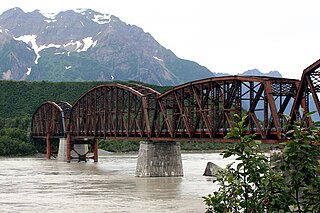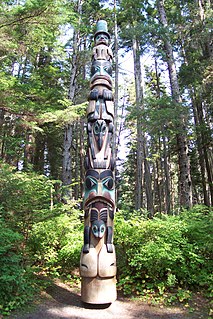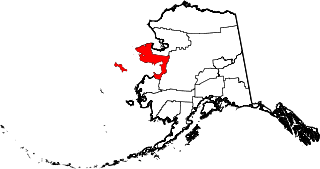
Chisana is a census-designated place (CDP) in the Copper River Census Area in the U.S. state of Alaska. As of the 2010 Census, the population of the CDP was 0. The English name Chisana derives from the Ahtna Athabascan name Tsetsaan' Na, meaning literally 'copper river'. The Chisana River joins the Nabesna River just north of Northway Junction, Alaska, to form the Tanana River, a major tributary of the Yukon River. The Chisana Airport consists of a turf and gravel runway which is largely serviced by flights from Tok, Alaska.

The Miles Glacier Bridge, also known as the Million Dollar Bridge, was built in the early 1900s across the Copper River fifty miles from Cordova in what is now the U.S. state of Alaska. It is a multiple-span Pennsylvania truss bridge which completed a 196-mile (315 km) railroad line for the Copper River and Northwestern Railway, built by J. P. Morgan and the Guggenheim family to haul copper from the old mining town of Kennicott, now located within the Wrangell–St. Elias National Park and Preserve, to the port of Cordova. It earned its nickname because of its $1.4 million cost, well recouped by the about $200 million worth of copper ore which was shipped as a result of its construction.

Fort Stevens was an American military installation that guarded the mouth of the Columbia River in the state of Oregon. Built near the end of the American Civil War, it was named for a slain Civil War general and former Washington Territory governor, Isaac I. Stevens. The fort was an active military reservation from 1863–1947. It is now listed on the National Register of Historic Places.

Coast Guard Base Kodiak is a major shore installation of the United States Coast Guard, located in Kodiak, Alaska. The largest tenant unit on the base is Air Station Kodiak. It is also the home port for several cutters. Historic elements that it includes are the Kodiak Naval Operating Base, Fort Greely, and Fort Abercrombie.

Sitka National Historical Park is a national historical park in Sitka in the U.S. state of Alaska. It was redesignated as a national historical park from its previous status as national monument on October 18, 1972. The park in its various forms has sought to commemorate the Tlingit and Russian experiences in Alaska.

Camp Douglas was established in October 1862, during the American Civil War, as a small military garrison about three miles east of Salt Lake City, Utah, to protect the overland mail route and telegraph lines along the Central Overland Route. In 1878, the post was renamed Fort Douglas. It was officially closed in 1991 pursuant to BRAC action and most of the buildings were turned over to the University of Utah. A small section of the original fort is still used by the U.S. Army Reserve and includes the Fort Douglas Military Museum. The fort was designated a National Historic Landmark in 1975, for its role in the Civil War and in furthering the settlement of Utah.

Old Fort Pierce Park is the site of Fort Pierce, a military installation constructed by the U.S. Army in Florida with the purpose of being a main supply depot for the army during the Second Seminole War. The modern town of Fort Pierce derives its name from this installation.

Fort William H. Seward, also known as Chilkoot Barracks and Haines Mission, is a site at Port Chilkoot in Haines Borough, Alaska, about 0.5 miles (0.80 km) from the city of Haines. It was the last of a series of 11 military posts established in Alaska during the gold rush era, and was Alaska's only military facility between 1925 and 1940. It provided a policing presence for miners moving into the gold mining areas in the Alaskan interior, and a military presence during negotiations over the nearby international border with Canada. The fort is named for William H. Seward, the United States Secretary of State who oversaw the Alaska purchase.

Fort Abercrombie State Historical Park, also known as the Fort Abercrombie State Historic Site, is an Alaska state park on Kodiak Island, Alaska. It includes 182 acres (74 ha) of land at the end of Miller Point, located on the eastern shore of Kodiak Island northeast of the city of Kodiak. The park, established in 1969, is noted for its historical World War II fortifications and its scenery, which includes bluffs overlooking the ocean, spruce forests, and meadows. The site was named in honor of the early Alaska explorer and United States Army officer Lt. Col. William R. Abercrombie. The fortifications, whose surviving elements include gun emplacements, underground magazines, and foundational remnants of buildings, were built in 1941 and abandoned after the war ended, having seen no action.

Fort Belle Fontaine is a former U.S. military base located in St. Louis County, Missouri, across the Mississippi and Missouri rivers from Alton, Illinois. The fort was the first U.S. military installation west of the Mississippi, in the newly acquired Louisiana Territory, and served as a starting point for many expeditions to the American West.

The Dutch Harbor Naval Operating Base and Fort Mears were the two military installations built next to each other in Dutch Harbor, on Amaknak Island of the Aleutian Islands in Alaska, by the United States in response to the growing war threat with Imperial Japan during World War II. In 1938, the Navy Board recommended the construction which began in July 1940. The first United States Army troops arrived in June 1941 and an air base constructed by the United States Navy was finished in September 1941. At the time of the surprise attack on Pearl Harbor, these were the only military installations in the Aleutian Islands.
Fort Egbert was a U.S. Army base in Eagle, Alaska. It operated from 1899 to 1911.

This is a list of the National Register of Historic Places listings in Bethel Census Area, Alaska.

This is a list of the National Register of Historic Places listings in Nome Census Area, Alaska.

St. Michael the Archangel Church is a historic Russian Orthodox church along Lake Avenue, in Cordova, Alaska. Now it is under Diocese of Alaska of the Orthodox Church in America.

The Mission Church is a historic Episcopal log church building on the eastern fork of the Chandalar River in Arctic Village, Alaska, inside the Arctic National Wildlife Refuge. Known also as Old Missionary Church and as Old Log Church, it was built in 1917. It was one of numerous mission churches established in Alaska by the Episcopal Church in the early 20th century.

The Old Mission House was a historic Episcopal church mission house in Fort Yukon, Alaska. It was constructed in 1925 as part of a Native American mission. It was the third mission house built on the site, nearly duplicating one built in 1914 and destroyed by fire. The house is a 2+1⁄2-story log structure in an L shape, with interior rooms constructed by frame construction. The building was the center of the religious mission, which provided educational and health services to the local Native population. This building was used as a school, providing boarding space for students from distant areas. In 1957 the building was adapted for use as the medical clinic after the previous clinic building was closed and later torn down.
Fort Gibbon was a U.S. Army base near Tanana, Alaska. It was active from 1899 to 1923.

Pilgrim Hot Springs is a ghost town in the interior of the Seward Peninsula of northwestern Arctic Alaska. Also known as Kruzgamepa, it is located on the southeast bank of the Kruzgamepa River, about 8 miles (13 km) south of milepost 65 of the Kougarok Road. The location gained prominence in the early 20th century because of its thermal hot springs, which made agricultural homesteading possible, and which were adapted to provide a respite for the gold miners of Nome. Early buildings, built 1900–03, were of log construction, and included a log cabin, barn and chicken house. A roadhouse and saloon were built after 1903, but were destroyed by fire in 1908, after the mining boom had ended.

St. Michael Redoubt was a fortified trading and supply post established by the Russian-American Company in 1833, at the location of what is now the city of St. Michael, Alaska. It is located on the southern shore of Norton Sound at a convenient location near the mouth of the Yukon River. The fort, established by order of Ferdinand Wrangel, was used in following decades as a logistics point for exploration of southwestern Alaska and the Alaskan interior via the Yukon and other rivers.



















